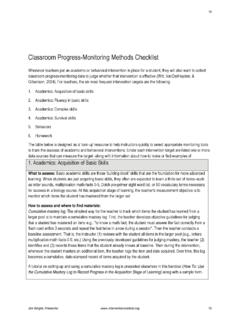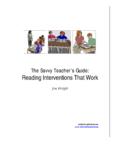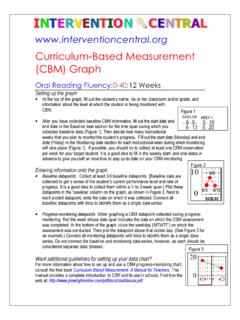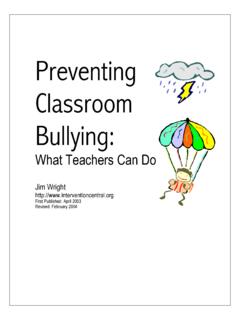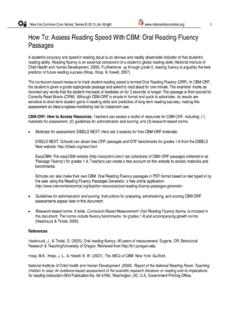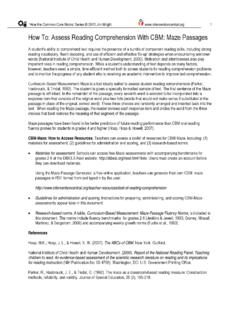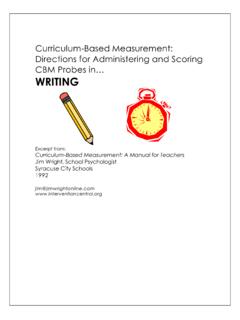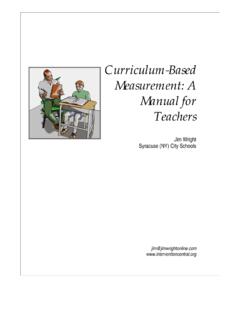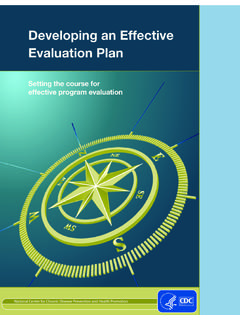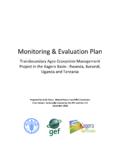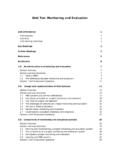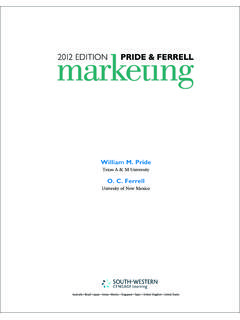Transcription of Developing Effective Tier 2 & Tier 3 RTI Reading ...
1 Response to InterventionDeveloping Effective tier 2 & tier 3 RTI tier 2 & tier 3 RTI Reading interventions : Gidli f Sh lGuidelines for SchoolsJim Wrightwww interventioncentral to InterventionIntervention Centralwww interventioncentral to InterventionWorkshop PPTs and handout available at: to InterventionChallenge 1: Where can a school find evidence-based di f Ti 2/3? Reading programs for tier 2/3?Challenge 2: What are the important quality indicators t Ti 2/3 RTI di i tti?to assess a tier 2/3 RTI Reading intervention?Challenge 3: How can schools measure the i tti i tit f Ti 2/3 di i tti?
2 Intervention integrity of a tier 2/3 Reading intervention?Challenge 4: How can schools find & use schoolwide i t l t id tif td t f Ti 2/3 screening tools to identify students for tier 2/3 interventions ?Ch ll 5 H hl ffiitl l Challenge 5: How can schools efficiently place students in appropriate tier 2/3 Reading services?Ch ll 6 Wh t dlt i Ti 2/3 6: What developments in tier 2/3 interventions can help students use skills independently?Response to InterventionEssential Elements of RTI (Fairbanks, Sugai, Guardino, & Lathrop, 2007)Essential Elements of RTI (Fairbanks, Sugai, Guardino, & Lathrop, 2007)1. A continuum of evidence-based services available to all students" that range from universal to highly ggyindividualized & intensive2.
3 Decision points to determine if students are performing significantly below the level of their peers performing significantly below the level of their peers in academic and social behavior domains"3. Ongoing monitoring of student progress"4. Employment of more intensive or different interventions when students do not improve in response" to lesser interventionsresponse to lesser interventions5. Evaluation for special education services if students do not respond to intervention instruction" : Fairbanks, S., Sugai, G., Guardino, S., & Lathrop, M. (2007). Response to intervention: Examining classroom behavior support in second grade. Exceptional Children, 73, p. to InterventionRTI Pyramid of tier 3: Intensive interventionsInterventions tier 3: Intensive who are non-responders to Tiers 1 & 2 are tier 3referred to the RTI Team for more intensive 2 Individualized of students receive interventions tier 2 tier 1: Universal interventionsstudents receive interventions targeting specific needs.
4 tier 1 tier 1: Universal to all students in a classroom or school. Can consist whole-group or individual strategies or to InterventionRTI Support: tier 1 Core Instruction tier 1 core instruction is considered to be universal because all students receive it and benefit from it. C i tti h ld i l d th lt f li it i tti Core instruction should include the elements of explicit instruction , a structured method for instructional delivery that is more likely to be Effective with struggling g To judge whether core instruction is adequate, RTI schools use screening instruments ( , Reading fluency & comprehension probes) to assess classwideperformance three times yearly If at least 80 percent of classwideperformance three times yearly.
5 If at least 80 percent of students attain or exceed the screener s performance benchmark, core instruction is considered to be : Lembke, E. S., Hampton, D., & Beyers, S. J. (2012). Response to intervention in mathematics: Critical ()pelements. Psychology in the Schools, 49(3), , J. (2012). RTI Success in Secondary Schools: A toolkit for middle and high schools. Port Chester, NY: National Professional Resources, to InterventionRTI Support: tier 1 (Classroom) InterventionTier 1 interventions are intended for red flag students who struggle in the content area(s) and require additional individualized teacher support during core instruction To successfully implement tier 1 support during core instruction. To successfully implement tier 1 interventions , a teacher will need: Clear criteria to identify tier 1 intervention students ( , students who are failing the course on a 5-week grade report).
6 Research-based strategies to address the student s academic (and perhaps motivational) deficitsperhaps motivational) deficits. A streamlined form to document the tier 1 intervention plan. The ability to collect and interpret classroom data to judge whether ypjgthe tier 1 intervention is working. Guidelines for how long to implement the tier 1 intervention before ki dditil RTI h l f th t additional RTI help for the : Wright, J. (2012). RTI Success in Secondary Schools: A toolkit for middle and high schools. Port Chester, NY: National Professional Resources, to InterventionRTI Support: tier 2/3 Supplemental interventions tier 2/3 interventions SUPPLEMENT core instruction. Students are identified for tier 2/3 services based on objective jdata sources such as universal screeners that allow the school to predict each student s degree of risk for academic failure.
7 In a typical school, 10-15 % of students may require tier 2 interventions in a given academic area. About 1-5 % of t dt d i ti Ti 3 i ttistudents may need more intensive tier 3 interventions . interventions at tier 2 are monitored at least twice per month. interventions at tier 3 are monitored weeklyInterventions at tier 3 are monitored weekly. Each tier 2/3 intervention should last at least 6-8 instructional : Wright, J. (2012). RTI Success in Secondary Schools: A toolkit for middle and high schools. Port Chester, NY: National Professional Resources, to InterventionRTI Support: tier 2/3 Supplemental InterventionsEach tier 2/3 intervention plan shows evidence that: Instructional programs or practices are evidence-based.
8 The intervention has been selected because it logically addresses the The intervention has been selected because it logically addresses the area(s) of academic deficit for the target student. The student-teacher ratio in the group provides adequate student support: gppqppTier 2 up to 7 students; tier 3 up to 3 students. NOTE: The instructional ratio for students engaged in computer-delivered tier 2/3 instruction is 1 d t ll d i th Ti 2/3 i tti h th hd Students enrolled in the tier 2/3 intervention group have the same shared intervention need(s). The intervention provides contact time adequate to the student academic ee e o p o des co ace adequa e oe s udeacade cdeficit. tier 2 interventions occur a minimum of 3 times per week in sessions of 30 mins or more; tier 3 interventions occur daily in sessions of 30 mins or more (Burns & Gibbons 2008) mins or more (Burns & Gibbons, 2008).
9 10 Sources: Wright, J. (2012). RTI Success in Secondary Schools: A toolkit for middle and high schools. Port Chester, NY: National Professional Resources, to InterventionLevels of Intervention: Tiers 1, 2 & 3 tier 1: Universal100% tier 2: Individualized~15% tier 3: Intensive~ 1-5% to InterventionAvg Classroom Academic Performance LevelDiscrepancy 1: Skill Gap Discrepancy 1: Skill Gap (Current Performance Level)Discrepancy 2:Gap in Rate of Learning ( Slope Target Student DualDiscrepancy : RTI Model Learning ( Slope of Improvement ) : RTI Model of Learning Disability(Fuchs 2003)Response to InterventionCommon Core State Standards InitiativeStandards the set of Common Core View the set of Common Core Standards for English Language Arts (including writing) and mathematics being adopted by mathematics being adopted by states across to InterventionCommon Core State Standards: Supporting Different Learners in Reading The Standards set grade-specific standards but do not The Standards set gradespecific standards but do not define the intervention methods or materials necessary to support students who are well below or well above grade-level expectations.)
10 No set of grade-specific standards can fully reflect the great variety in abilities, needs, learning t d hit ll f t dt i i rates, and achievement levels of students in any given classroom. :National Governors Association Center for Best Practices and Council of Chief State School Officers. (2010). Common Core State Standards for English Language Arts & Literacy in History/Social Studies, Science, and Technical Retrievedon September 23, 2012, from ; p. to InterventionCommon Core State Standards: ..It is also beyond the scope of the Standards to define the Supporting Different Learners in is also beyond the scope of the Standards to define the full range of supports appropriate for English language learners and for students with special needs.
